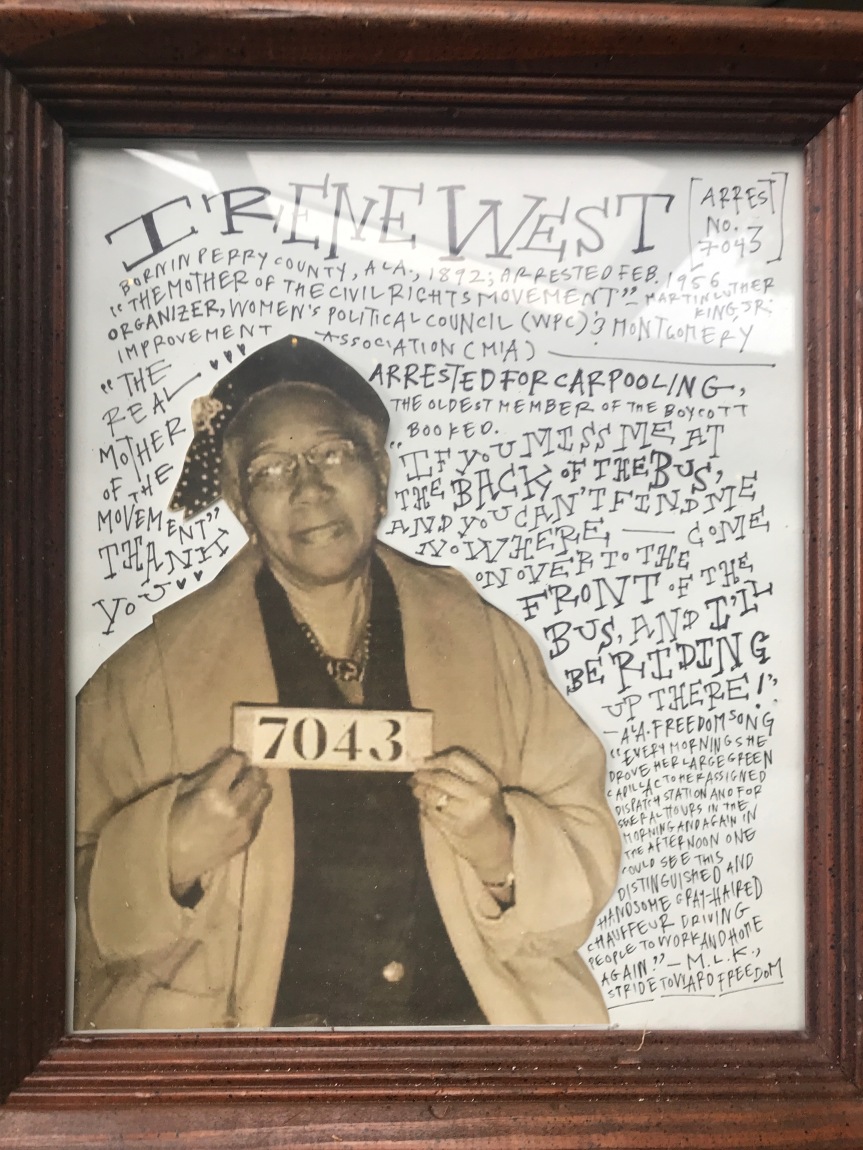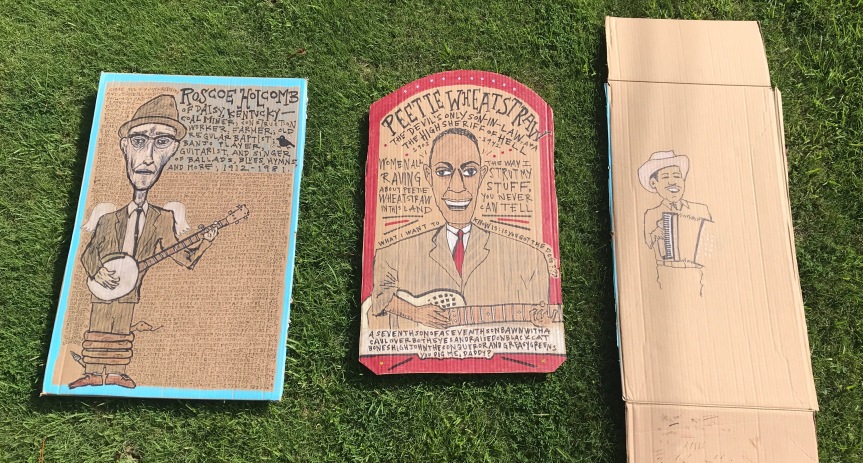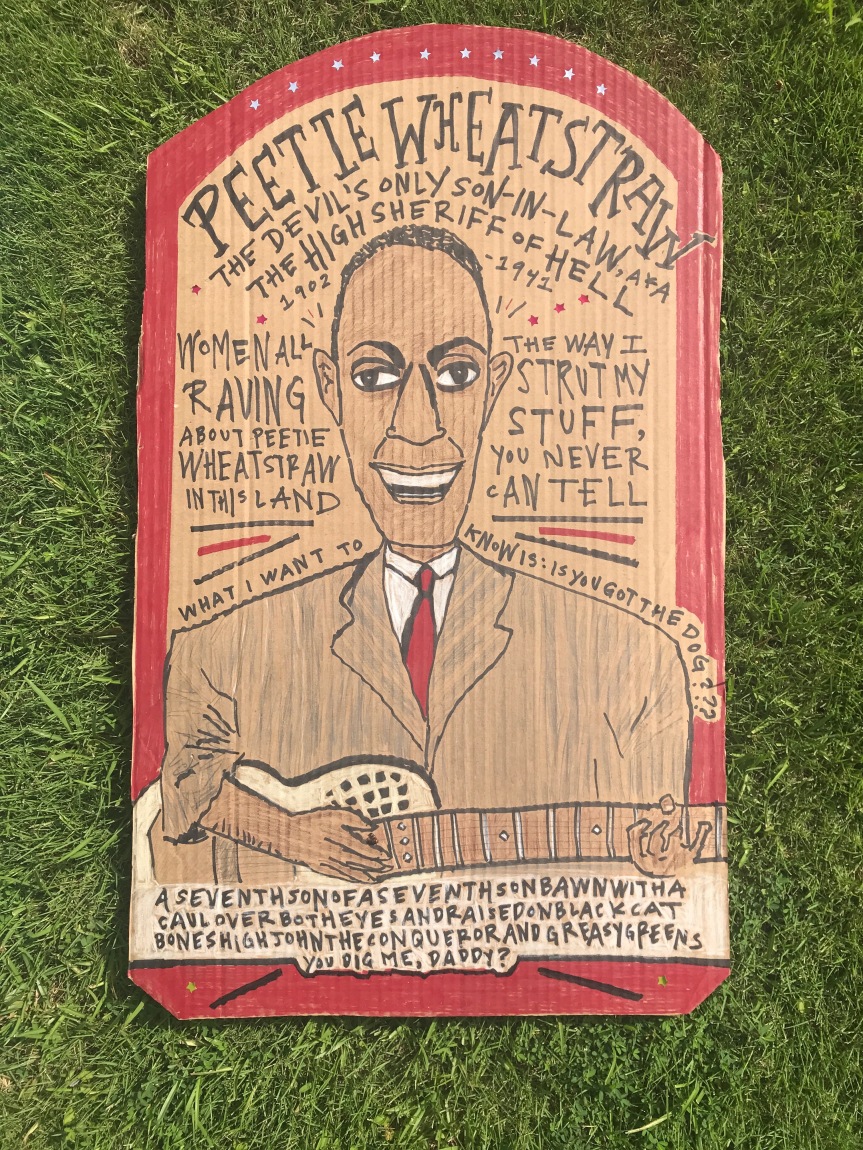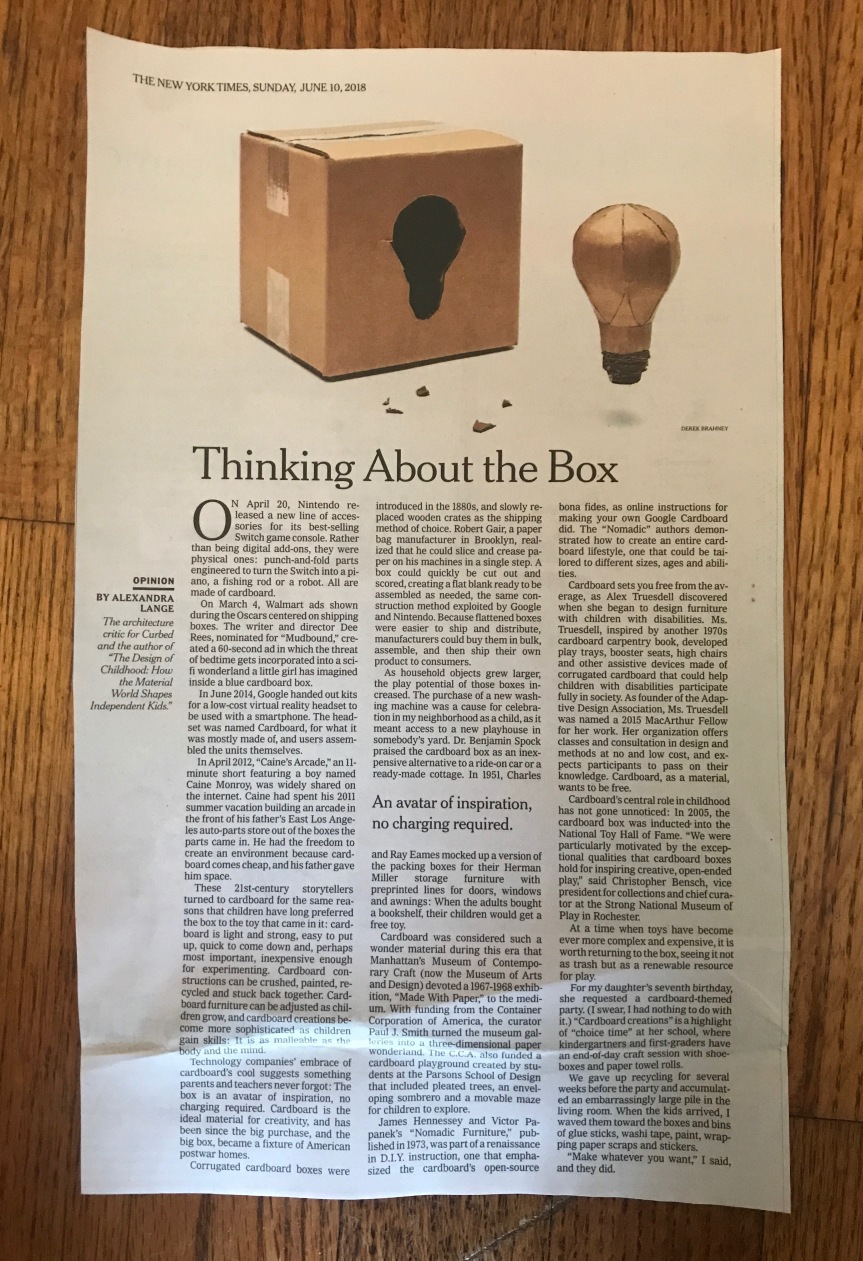Back in April, I started drawing on a big, empty cardboard box, and I promised to share the results here as they unfolded, posting occasional updates until I could share the fully finished outcome. (Here’s the original post, where you can see where I started and read my reasons for posting the progress.) There haven’t been any updates since then, because for about two months I didn’t touch the box again. So it goes.
For better and/or worse, this is the way I do tend to operate: it’s usually the way I draw pictures, and the way I write. I get two-thirds or three-quarters the way through something and then get stuck and put it aside — sometimes for a few years at a time. If I’m lucky, I’ll eventually come back to whatever it is and finish it. There’s something worthwhile, of course, in letting things gestate or simmer, but on the whole I wish I had the discipline to push things through to their end more quickly. Ah, well. I guess we all do the best we can, however we can.
One reason progress is slow is that I always take up and get distracted by other projects in the meantime — so, to show how this one box has evolved, here’s, first, a bit of what’s been evolving alongside and taking me away from my original box. For a couple of upcoming radio shows I decided to make a couple of unusually large radio advertisements, also on cardboard, which will appear around town over the next couple of weeks. Next week on the radio I’ll be spotlighting Leadbelly’s last sessions, from 1948; a week after that, I’ll be playing Woody Guthrie’s Library of Congress recordings, from 1940. So, while listening to all those recordings, trying to narrow down the playlists, I made these:
Meanwhile, I’ve begun a larger project I’m calling my “Book of Ancestors”: a series of tributes to various change-makers, icons, and half-forgotten heroes from my home state of Alabama, all made up out of historic photos, handwritten text, and stately thrift-store frames. There will be more than a hundred of these when I’m done; so far I’ve got a good dozen or so. There’s an entire sub-section-in-progress featuring the women of the Montgomery Bus Boycott. For example, Irene West:

Poor Glory! She lives in a house full of cardboard boxes, half-covered in Sharpie drawings, stacked against the walls alongside piles of clunky brown thrift-store frames. Her patience and encouragement are remarkable. I am lucky.
But back to the real point of this post: last weekend I did at last make some progress on my box, X-acto knifing it into its separate segments and adding some color and words — and a little birdie (there are so many little birds in Roscoe Holcomb songs!) and some star stickers like you used to get in second or third grade. I think Peetie Wheatstraw is probably as done as he’ll get; there’s a little text left to add to Roscoe Holcomb, but I went ahead and put him aside for now. Los Pinguinos del Norte are still where I left them last, with half a Pinguino and 3.5 Pinguinos to go. So, wish me luck and stay tuned.


 While working on all these pieces of cardboard, I came upon a great little article in the Sunday New York Times: “Thinking About the Box,” a tribute to the endless potentials of the cardboard box. The author, Alexandra Lange (whose book, The Design of Childhood: How the Material World Shapes Independent Kids, came out earlier this month) begins by citing several recent high-profile appropriations of the good old cardboard box — by the likes of Google, Wal-Mart, and Nintendo. Lange explains cardboard’s enduring appeal like this: “These 21st-century storytellers turned to cardboard,” she writes, “for the same reasons that children have long preferred the box to the toy that came in it: cardboard is light and strong, easy to put up, quick to come down and, perhaps most important, inexpensive enough for experimenting. Cardboard constructions can be crushed, painted, recycled and stuck back together. Cardboard furniture can be adjusted as children grow, and cardboard creations become more sophisticated as children gain skills: It is as malleable as the body and mind.” To all that I say only amen. Lange goes on to explain how the cardboard box became a fixture in the imagination of the American child, “an avatar of inspiration, no charging required.” It’s a short read well worth your while:
While working on all these pieces of cardboard, I came upon a great little article in the Sunday New York Times: “Thinking About the Box,” a tribute to the endless potentials of the cardboard box. The author, Alexandra Lange (whose book, The Design of Childhood: How the Material World Shapes Independent Kids, came out earlier this month) begins by citing several recent high-profile appropriations of the good old cardboard box — by the likes of Google, Wal-Mart, and Nintendo. Lange explains cardboard’s enduring appeal like this: “These 21st-century storytellers turned to cardboard,” she writes, “for the same reasons that children have long preferred the box to the toy that came in it: cardboard is light and strong, easy to put up, quick to come down and, perhaps most important, inexpensive enough for experimenting. Cardboard constructions can be crushed, painted, recycled and stuck back together. Cardboard furniture can be adjusted as children grow, and cardboard creations become more sophisticated as children gain skills: It is as malleable as the body and mind.” To all that I say only amen. Lange goes on to explain how the cardboard box became a fixture in the imagination of the American child, “an avatar of inspiration, no charging required.” It’s a short read well worth your while:
 Of course, as an art supply cardboard also has these obvious benefits: there’s plenty of it to be found, for free, and you can mess around with and draw on it without creating more waste in the world. In short, you have nothing to lose. My friend Lillis Taylor, one of my favorite artists (please check out her March Quilts project and her non-profit sew-op, Bib & Tucker), likes to quote these lines from Howard Finster, and his words seem relevant here — and relevant, really, to anyone interested in making new things out of old things:
Of course, as an art supply cardboard also has these obvious benefits: there’s plenty of it to be found, for free, and you can mess around with and draw on it without creating more waste in the world. In short, you have nothing to lose. My friend Lillis Taylor, one of my favorite artists (please check out her March Quilts project and her non-profit sew-op, Bib & Tucker), likes to quote these lines from Howard Finster, and his words seem relevant here — and relevant, really, to anyone interested in making new things out of old things:
Washed by rain and dried by sun
A million pieces all in one.”
And that, too, reminds me of this: how just this week an unexpected email from a stranger brought me happily back to an old friend, Ernest Mostella, who used to carve these extraordinary homemade fiddles out of chunks of longleaf pine. He was in his nineties when I met him some twenty years ago, and he whittled the pieces down with a chainsaw, pieced it all together with carpenter’s glue (sometimes he made his own glue out of sawdust and egg yolks), and strung it up with thick, ropey twine. I’m reminded I need to pick up a project I started, all those years ago, to document his fiddles and his voice and his story, and I look forward to digging back into it all very soon. As usual (see above), I got distracted, but this too will get done.
Finally, also, while I’m at it, this: I’m so happy to have stumbled at last upon #drawgandhi, a practice in progress by Birmingham’s own Glenny Brock. You should check it out on Instagram, and see Glenny’s talk, “What I Learned By Drawing Gandhi.”
That’s all for now, friends. Everybody, go make something.
Peace.
P. S. If you like this sort of thing, you can support the endeavor by doing any of the following: follow this blog by signing up on the righthand side of this page (you’ll get about 2 posts a month in your email inbox); follow @lostchildradio on Instagram; or “like” my book and/or radio show on Facebook. You can purchase my book with Alabama jazzman “Doc” Adams online or at your local bookstore. Heartfelt thanks, sincerely, for any / all of the above.


Burgin, I just love reading your posts and am always reminded what a creative, joyful spirit you are! It’s no wonder your students love you. I bet many of them look back and say that you were the most inspirational teacher they had. You teach in everything you do. I learned in this post your method of creating: 2/3-3/4, puse, finish (or not). I think that’s a great way to do anything. I think it’s the pause that gives you time to think, reflect, and adds depth. Thanks for sharing!
>
LikeLiked by 1 person
Thank you, Pat!
LikeLike